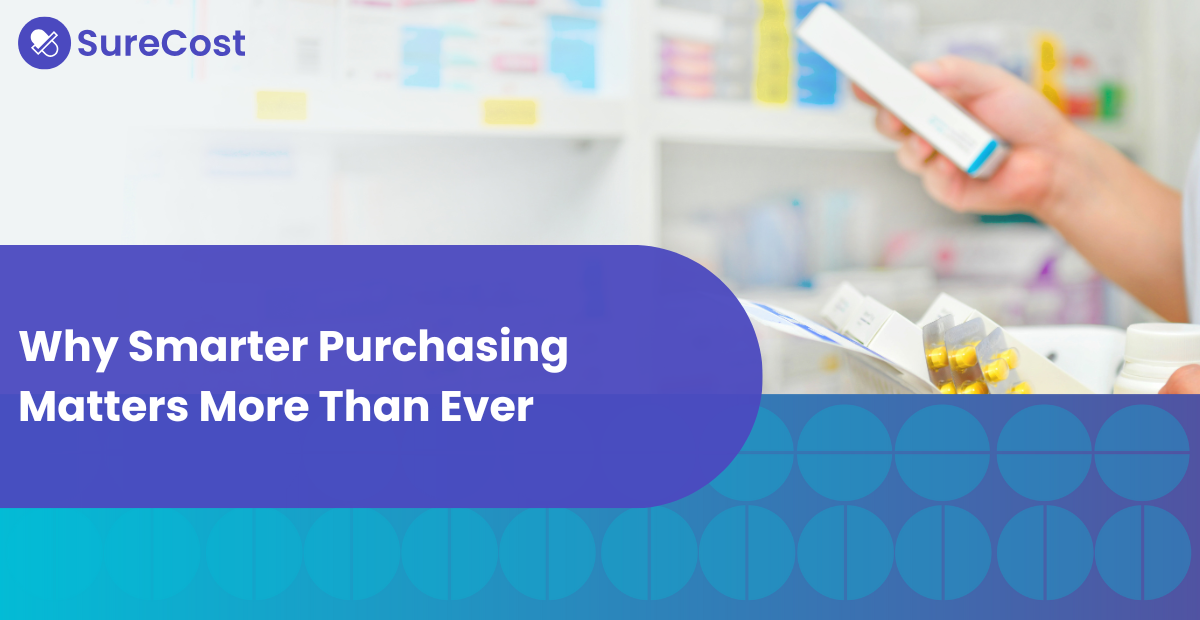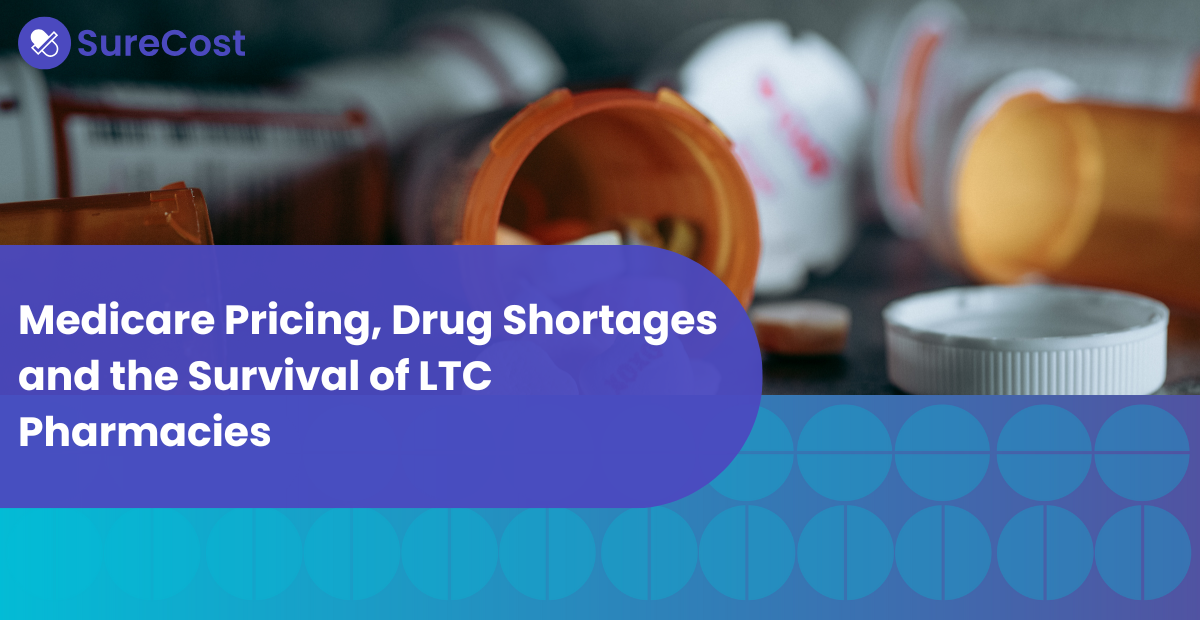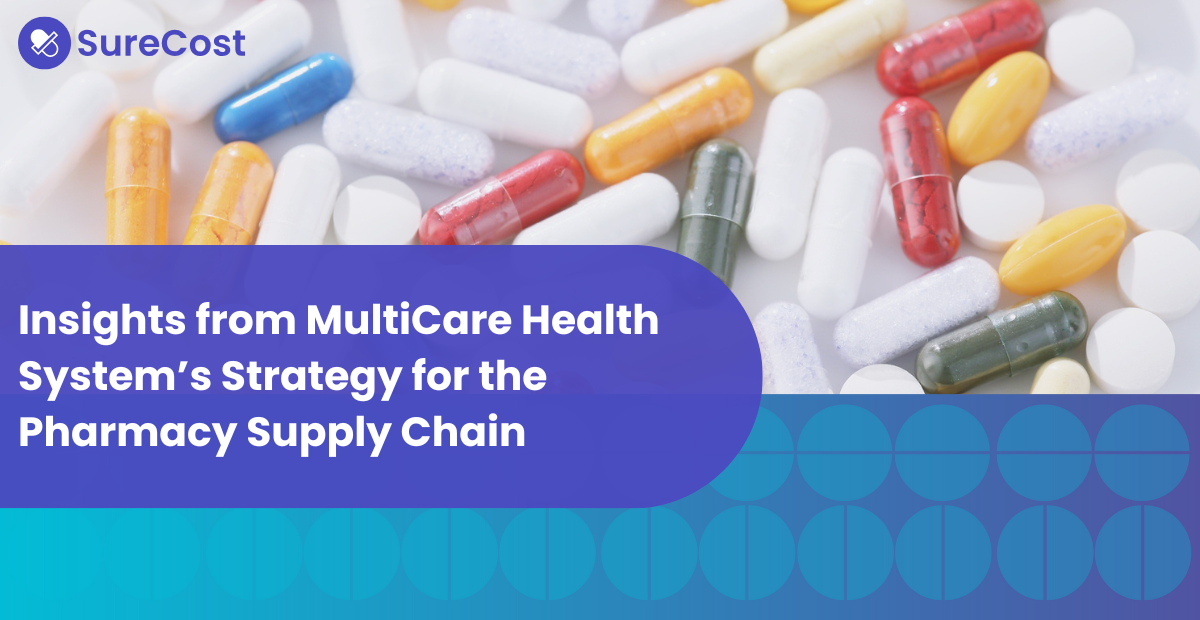In a complex and competitive pharmacy purchasing ecosystem, pharmacies must utilize every means to enhance their purchasing decisions while streamlining their operations and ensuring compliance.
This blog post will show you why smarter purchasing is more crucial than ever. First, we’ll provide an overview of the challenging landscape for pharmacies. We’ll then share some insights from our latest Smarter Purchasing Report and “preview” how successful pharmacies thrive despite these mounting pressures.
Inflation and Drug Prices
The Inflation Reduction Act (IRA) caps manufacturers’ prices on Medicare-covered drugs and lowers patients’ out-of-pocket expenses. It’s an understandable initiative since inflation is a significant factor in rising drug prices.
Inflation affects materials, labor, and transportation costs, driving up distribution and production costs for drug manufacturers and ultimately leading to higher prices for drugs. Generic drugs are especially sensitive to inflation, but drugmakers can also charge more for their more exclusive brand-name options. Insurance carriers will adjust to higher reimbursements for prescription pharmacy products by changing their rates. Public programs like Medicare and Medicaid often change which drugs they’ll cover.
All these impacts lead to higher costs for patients. Yet while the IRA has an admirable goal, it will also drastically cut your pharmacy’s margins. That’s because manufacturers launch new drugs at higher prices, commercial plans will adjust to compensate and PBMs will change formularies due to lower margins.
Pharmacies also end up laying out significant amounts just to purchase popular drugs. Payment delays for refunds from drugmakers will result in huge financial losses for pharmacies. One source predicts a weekly liquidity gap of $10.8K and an average profit decline of 6% for specific drugs.
Complex Vendor Dynamics
Pharmacy purchasing involves a complex network of different parties and data. Primary vendor compliance alone is a complicated and potentially costly issue. Vendor agreements are complex. Many pharmacies don’t fully understand how compliance is calculated. They may fail to meet compliance targets when making purchases and incur penalties. Pharmacies often miss minimum spend requirements, lose out on additional savings or don’t optimize their generic spend for the best rebate potential.
But compliance is a two-way street. One of the more “surprisingly consistent” findings of SureCost’s Smarter Purchasing Report is the amount of money pharmacies are losing to unintentional but expensive mistakes by vendors.
For example, pharmacies have incurred significant losses due to discrepancies between the actual value of goods they received and the amounts vendors invoiced them. Even a low percentage of incorrect quantities, unshipped items and “miss-picks” (i.e., billing for incorrect items) can mean huge financial losses. Consider a pharmacy that purchases approximately $3M annually. A half of a percentage point overpayment for products invoiced but not received against their COGS would mean a $300K annual loss.
Pharmacies also continue to see unexpected vendor substitutions in their purchasing: Vendors send products that are different from what pharmacies ordered and don’t inform the pharmacies. Even low-frequency substitutions can have a financially significant impact at scale. One pharmacy saw a six-figure increase in COGS just due to substitutions.
If you could ensure 100% compliance with your primary vendor and by your primary vendor, purchasing still means navigating primary vendors, manufacturers, GPOs and buying groups as well as secondary and even tertiary vendors plus 340B splitters for health system pharmacies. It involves multiple catalogs and purchasing interfaces. That’s hours lost to shopping.
Just buying the right product means analyzing numerous factors:
- Cost (which isn’t necessarily the lowest “sticker price”)
- Availability, subject to constant changes
- Cost of goods sold (COGS)
- Type
- Quantity
- Impact on compliance
- Package size
- Potential rebate
- Cost to change
That’s a lot to analyze for each and every purchase! The data is often spread across multiple catalogs and purchasing interfaces, leaving teams to manually scan multiple windows on a screen and select the best option on their own. We know pharmacy staff are already overwhelmed, but manual purchasing is too much for any team without the right tools and strategy.
Regulatory Pressure
Losing money is harmful enough. Failing to meet regulatory compliance can result in audits, costly financial penalties, suspension or even legal action. But regulations like DSCSA are incredibly complex and potentially very risky.
At SureCost, we’ve covered the changing requirements of DSCSA and multiple postponements and adjustments. This is just a brief summary of the current DSCSA requirements that pharmacies will be responsible for:
- Package-level T2 product-tracing data
- EPCIS standard
- Six years of data in electronic format
- Updated procedures for checking for suspicious products at the package level
- Ability to quarantine and report suspect product within 24 hours
- Respond to audit requests within 48 hours
Last October, the FDA added exemption deadlines for DSCSA based on an entity’s licensed employee count as of November 27, 2024:
- Dispensers with 25 or fewer full-time licensed employees: until November 27, 2026
- Dispensers with 26 or more full-time licensed employees: until November 27, 2025
- Manufacturers and repackagers: until May 27, 2025
- Wholesale distributors: until August 27, 2025
Pharmacies should always consult the latest regulations, requirements and updates while seeking the advice of a licensed attorney for all legal questions and concerns.
But while covering these updates and discussing them with pharmacy professionals, we’ve seen the level of technical sophistication needed just to remain compliant.
However, your pharmacy must do more than just keep up. You need to maintain consistent DSCSA compliance without complicating your existing operations. That means tracking, verifying and storing massive quantities of electronic data throughout your purchasing process—not as a siloed process or after you’ve put items on your shelves.
Smarter Purchasing Means in Today’s Pharmacy Environment
These are just some of the mounting challenges your pharmacy faces. Drug shortages and a dwindling pool of qualified staff are more reasons to adopt smarter purchasing.
What is smarter purchasing? In a nutshell, it means leveraging technology and implementing strategies that optimize your procurement process. Smarter purchasing is designed to maximize savings and optimize compliance, while empowering you and your team to work more efficiently.
Managing purchasing and inventory through a unified solution is a cornerstone of smarter purchasing. Integrated purchasing means shopping, purchasing, receiving and managing all other aspects of procurement through a single interface. Your pharmacy will have a comprehensive overview, updated in real time, of available purchasing options from all of your vendors. You can then instantly analyze options based on your strategy, make data-driven decisions and upload purchase orders through a single interface.
Integrating this solution with other functions and systems strengthens relationships with vendors. For example, when purchasing, you can see the impact of different purchasing options on primary vendor compliance in real time. You can now shop an expanded catalog without compromising compliance. Then, streamlined receiving means instantly confirming the right product, quantity and price as soon as you receive items. If there’s a discrepancy, you have the requisite electronic “paper trail” of data to easily resolve it with the source.
The validation process includes required DSCSA data. Instead of a separate process (that risks manual error or non-compliant storage), a smarter purchasing solution automatically tracks, confirms and records the mandated information in the required format at receiving.
Smarter purchasing also means automating repetitive, error-prone manual processes. Instead of spending time on tedious tasks like juggling vendor catalogs, staff can concentrate on patients and other high-value work.
Surprising Pharmacy Purchasing Discoveries
Each year, SureCost publishes the Smarter Purchasing Report to share how successful pharmacies enhance patient care, save money and optimize their work. This year’s report highlighted pharmacies confronting the challenges above. We saw examples of pharmacies discovering problems after the fact and learned how successful pharmacies proactively anticipated these issues.
Among some of the other strategies and discoveries in the report, we found:
- Why shopping outside the top 200 generics drugs saved pharmacies over $255 million annually
- How reorders drove one pharmacy’s COGS up by nearly $2M
- The relationship between automation and easing staff burnout
- The multimillion-dollar difference that catching mismatched invoices can make
Download the report now for an expanded view of what your pharmacy can do to stay competitive and offer the best care to your patients.





.png)
